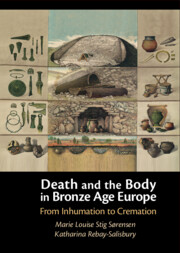Book contents
- Death and the Body in Bronze Age Europe
- Death and the Body in Bronze Age Europe
- Copyright page
- Contents
- Figures
- Tables
- Acknowledgements
- One Introduction
- Two A Brief History of Urns, Urnfields, and Burial in the Urnfield Culture
- Three Theoretical Framework
- Four The Bronze Age
- Five The Changing Bronze Age Body
- Six The Treatment of the Body
- Seven The Construction of Graves
- Eight After the Burial
- Nine Conclusions
- References
- Index
Eight - After the Burial
Prolonged Engagement with the Body
Published online by Cambridge University Press: 22 December 2022
- Death and the Body in Bronze Age Europe
- Death and the Body in Bronze Age Europe
- Copyright page
- Contents
- Figures
- Tables
- Acknowledgements
- One Introduction
- Two A Brief History of Urns, Urnfields, and Burial in the Urnfield Culture
- Three Theoretical Framework
- Four The Bronze Age
- Five The Changing Bronze Age Body
- Six The Treatment of the Body
- Seven The Construction of Graves
- Eight After the Burial
- Nine Conclusions
- References
- Index
Summary
Post-burial engagement with graves can take different forms. One obvious motivation (based on historical, ethnographic, and contemporary evidence) is to visit the grave to cater to the perceived needs of the deceased and for social-community reasons, probably at meaningful dates like the anniversary of death or at important times in the community’s calendar. It is, however, mostly impossible to tell whether this was part of Middle Bronze Age communities’ worlds and rituals. The continued effort invested in the physical construction of graves in many (but not all) the areas studied does, however, suggest that graves continued to be meaningful places and had some kind of significance beyond the short duration of the burial itself. ‘Having a place to go to’ for post-funerary practices can be necessary for mourning and various issues of societal cohesion and restructuring, drawing attention to the importance of creating a place where the living and dead can interact, and where cross-generational connections can be confirmed. In some ways, the ‘final resting place’ of the body – the grave, the burial mound, or the place in a cemetery – is a natural location for post-funerary practices. In this context, it is interesting to note that in our own society, cremation burials in communal graveyards and ‘woodland burials’, which are becoming increasingly popular in Europe, appear to drop the concern with making a specific place. This renunciation of an individualised burial place is often explained in terms of a decreased emphasis on community cohesion and genealogy, expressed, for instance, through the wish not to burden children or relatives who would have to maintain the graves, or it is due to environmental concerns. In our time, a place of memorialisation mainly seems to matter in cases of accidents and atrocities. Increasingly we witness crosses and candles placed at sites of such events, including terrorist attacks, like the marking of the March 11, 2004 attacks at the Atocha train station in Madrid (Margry and Sánchez-Carretero 2011, Sánchez-Carretero 2006, Truc and Sánchez-Carretero 2019). To move beyond generalised expectations about people’s behaviour and need to remember, we do, however, need to locate the specifics of whether and how this was indeed part of the Middle Bronze Age community’s mortuary practices. Were such needs invested in, and accommodated by, the burial constructions or in other ways performed and reiterated? For this argument, it is important to recognise the difference between individual involvement, which may have used a range of unauthorised and personal outlets, and that of sanctified social practices through which such post-cremation death practices were incorporated into the cultural canon.
- Type
- Chapter
- Information
- Death and the Body in Bronze Age EuropeFrom Inhumation to Cremation, pp. 174 - 190Publisher: Cambridge University PressPrint publication year: 2023



